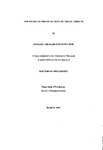THE POTENTIATION OF ACTIONS BY VISUAL OBJECTS
| dc.contributor.author | TUCKER, MICHAEL RICHARD EDWIN | |
| dc.contributor.other | School of Psychology | en_US |
| dc.date.accessioned | 2013-09-24T12:54:19Z | |
| dc.date.available | 2013-09-24T12:54:19Z | |
| dc.date.issued | 1997 | |
| dc.identifier | NOT AVAILABLE | en_US |
| dc.identifier.uri | http://hdl.handle.net/10026.1/1943 | |
| dc.description.abstract |
This thesis examines the relation between visual objects and the actions they afford. It is proposed that viewing an object results in the potentiation of the actions that can be made towards it. The proposal is consistent with neurophysiological evidence that suggests that no clear divide exists between visual and motor representation in the dorsal visual pathway, a processing stream that neuropsychological evidence strongly implicates in the visual control of actions. The experimental work presented examines motor system involvement in visual representation when no intention to perform a particular action is present. It is argued that the representation of action-relevant visual object properties, such as size and orientation, has a motor component. Thus representing the location of a graspable object involves representations of the motor commands necessary to bring the hand to the object. The proposal was examined in a series of eight experiments that employed a Stimulus- Response Compatibility paradigm in which the relation between responses and stimulus properties was never made explicit. Subjects had to make choice reaction time responses that mimicked a component of an action that a viewed object afforded. The action-relevant stimulus property was always irrelevant to response determination and consisted of components of the reach and grasp movement. The results found are not consistent with explanations based on the abstract coding of stimulus-response properties and strongly implicate the involvement of the action system. They provide evidence that merely viewing an object results in the activation of the motor patterns necessary to interact with them. The actions an object affords are an intrinsic part of its visual representation, not merely on account of the association between objects and familiar actions but because the motor system is directly involved in the representation of visuo-spatial object properties. | en_US |
| dc.language.iso | en | en_US |
| dc.publisher | University of Plymouth | en_US |
| dc.title | THE POTENTIATION OF ACTIONS BY VISUAL OBJECTS | en_US |
| dc.type | Thesis | |
| plymouth.version | Full version | en_US |
| dc.identifier.doi | http://dx.doi.org/10.24382/4955 | |
| dc.identifier.doi | http://dx.doi.org/10.24382/4955 |
Files in this item
This item appears in the following Collection(s)
-
01 Research Theses Main Collection
Research Theses Main


